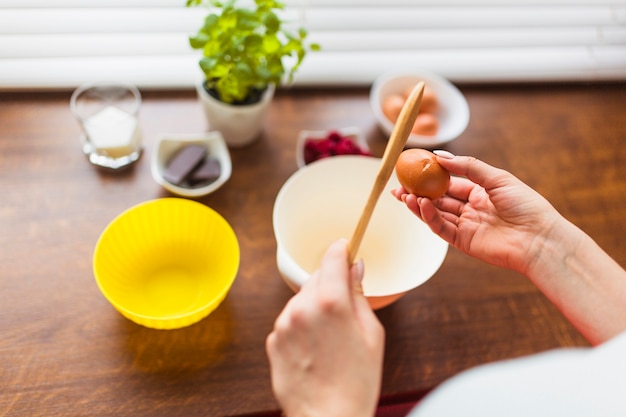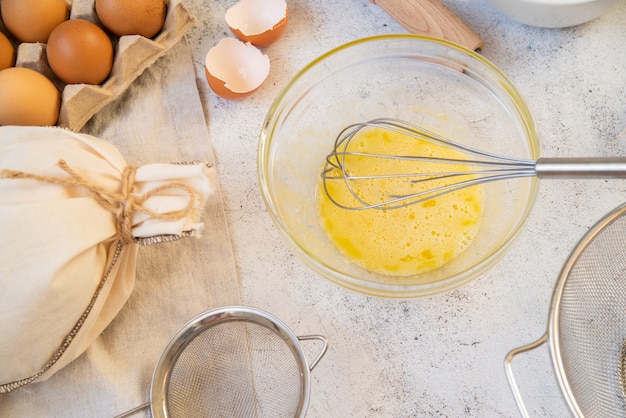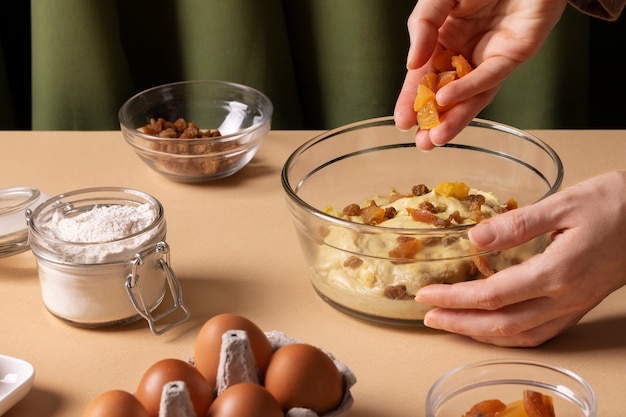deviled eggs. Just the name conjures up images of classic picnics, summer barbecues, and potlucks overflowing with deliciousness. It's a dish that evokes nostalgia, reminding us of simpler times and shared meals. But making a truly perfect deviled egg isn't just about boiling an egg and slapping some mayo on top. It's an art form, a culinary symphony of textures and flavors, and I'm here to be your conductor, guiding you through the process of creating the most delectable deviled eggs you've ever tasted.
(Part 1) The Eggs: Choosing Your Weapons

You know the old saying, "You can't make a silk purse out of a sow's ear"? Well, the same applies to deviled eggs. You need the right foundation, and that foundation is the egg itself.
The Freshness Factor
Freshness is key! I'm talking about those eggs that haven't been sitting in your fridge for weeks on end. A fresh egg will have a firm yolk, the kind that will hold its shape and create a beautiful, creamy texture in your filling.
How to Tell If an Egg is Fresh
There's a little trick my grandma taught me: hold the egg up to your ear and give it a gentle shake. If you hear a little sloshing, the yolk is moving around, and the egg is likely a bit older. If it's silent, you've got a fresh one!
The Fridge is Your Friend
Of course, we all keep our eggs in the fridge, right? But even in the fridge, eggs have a shelf life. So, if you've got a big gathering coming up, try to pick up some fresh eggs just before you start.
(Part 2) Boiling the Eggs: It's All About Timing

Now, boiling the eggs is where the real magic happens. You want to cook them just long enough to set the yolk perfectly, without making it rubbery. Think of it like a dance: a delicate balance between heat and time.
The Perfect Boil: A Step-by-Step Guide
Here's how to get it right:
1. Pot Party: Fill a large pot with enough water to cover the eggs by at least an inch. Bring it to a rolling boil.
2. Egg Drop: Gently lower the eggs into the boiling water.
3. The Ten-Minute Rule: Set your timer for 10 minutes. This is the magic number for perfectly cooked yolks.
4. ice bath: After 10 minutes, drain the hot water and immediately fill the pot with cold water. This stops the cooking process and makes the eggs much easier to peel.
5. Cooling Down: Let the eggs cool completely in the ice bath. This is a crucial step, as it ensures the yolk solidifies properly.
Peeling Tips: Conquering the Shell
peeling boiled eggs can be a bit of a nightmare, but don't despair! Here are a few tips to make it easier:
Crack the Shell: Gently crack the shell all around the egg.
Roll It Out: Roll the egg between your hands to loosen the shell further.
Water Works: If the shell is still clinging on, try peeling the egg under cold running water. The water helps loosen the shell and makes peeling a breeze.
(Part 3) The Filling: The Heart of the Deviled Egg

Ah, the filling. This is where you get to express your creativity and create your own signature deviled egg masterpiece.
The Classic Filling: A Timeless Delight
For those who appreciate the simplicity of tradition, there's the classic deviled egg filling. It's a combination of creamy mayonnaise, tangy mustard, and a touch of salt and pepper. Simple, but oh so satisfying.
Ingredients:
- 6 hard-boiled eggs
- 1/2 cup mayonnaise
- 1 tablespoon yellow mustard
- 1/4 teaspoon salt
- 1/8 teaspoon black pepper
Instructions:
1. Slice and Scoop: Cut the eggs in half lengthwise and carefully scoop out the yolks into a bowl.
2. Mash and Mix: Mash the yolks with a fork until they are smooth and creamy.
3. Adding the Flavor: Add the mayonnaise, mustard, salt, and pepper to the mashed yolks and mix well.
4. Filling Time: Use a spoon or a piping bag to fill the egg whites with the yolk mixture.
Adding Some Flair: My Personal Favorite Twists
Now, if you're looking to break free from the traditional and add a bit of your own personality to the filling, here are a few ideas that have become my personal favorites:
Smoky Sensations: A pinch of smoked paprika adds a smoky, depth of flavor to the classic filling.
Fresh Herb Delight: A sprinkle of fresh dill adds a bright, herbaceous touch that complements the richness of the mayonnaise.
A Touch of Heat: For those who like a little kick, add a teaspoon of horseradish to the filling.
Bacon Bliss: crispy bacon crumbles add a salty, savory note that's sure to please.
(Part 4) Garnish: The Finishing Touch
Okay, you've got your perfectly cooked eggs and your flavorful filling. Now it's time to add that final touch of artistry - the garnish.
The Essential Paprika Sprinkle
I always start with a sprinkle of paprika. It adds a touch of color, a hint of spice, and a professional finish.
Popular Garnishing Options: A Rainbow of Choices
But the world of deviled egg garnishes is your oyster! Here are a few popular options to get your creative juices flowing:
- Chopped Chives: Fresh chives add a vibrant green color and a subtle onion flavor.
- Chopped Parsley: Parsley provides a bright, fresh taste and a delicate, leafy texture.
- Chopped Dill: Dill offers a distinctive, aromatic flavor and a beautiful, feathery garnish.
- Caviar: For an elegant touch, top your deviled eggs with a dollop of caviar.
- Chopped Bacon: Crispy bacon adds a salty, smoky crunch.
- Toasted Bread Crumbs: Toasted bread crumbs offer a rustic, crunchy texture and a hint of toasted flavor.
- A Drizzle of Hot Sauce: For those who like a little heat, a drizzle of hot sauce adds a fiery kick.
My Favorite Garnishing Trick: A Touch of Elegance
I like to use a piping bag to create a little swirl on top of my deviled eggs. It looks really elegant and it's surprisingly easy to do. Just fill a piping bag with the filling and pipe it onto the eggs. Then, garnish with your favorite toppings.
(Part 5) Storage: Keeping Your Deviled Eggs Fresh
You've put your heart and soul into creating these delicious deviled eggs, so you want them to stay fresh and flavorful until they're ready to be devoured.
Storage Tips: Preserving Perfection
Here's how to store them properly:
Airtight Container: Store your deviled eggs in an airtight container. This will help to keep them fresh and prevent them from drying out.
Chilling Out: Store your deviled eggs in the refrigerator for up to 2 days.
Temperature Control: Keep your deviled eggs refrigerated at a temperature of 40°F (4°C) or below.
(Part 6) The Final Word: The Best Deviled Egg Ever!
Over the years, I've made countless deviled eggs, experimenting with different ingredients, flavors, and garnishes. But I'm always looking for new ways to improve, to create the ultimate deviled egg experience.
The Deviled Egg Challenge: Share Your Secrets!
If you've got a favorite deviled egg recipe or garnish, please share it with me in the comments below. I'm always up for a new challenge!
(Part 7) Serving Time: Let's Get This Party Started
Now, when it comes to serving your deviled eggs, I like to keep it simple and elegant. I usually place them on a platter with a small bowl of garnishes on the side.
Presentation Tips: Making Your Deviled Eggs Shine
Here are a few tips to elevate your deviled egg presentation:
Variety is the Spice of Life: Offer a variety of toppings for your guests to choose from. Let them personalize their deviled egg experience.
Neat and Tidy: Arrange your deviled eggs neatly on a platter. A little bit of symmetry goes a long way!
Chilling Time: Chill your deviled eggs for at least 30 minutes before serving. This helps them to firm up and ensures they're nice and cold.
(Part 8) Deviled Eggs Through the Ages: A Bit of History
You know, I was reading the other day about the history of deviled eggs. It turns out that they've been around for centuries!
A Long and Delicious History: From Ancient Rome to Modern Day
Deviled eggs have been a popular food in many cultures for a long time. They're thought to have originated in ancient Rome, where they were made with eggs, spices, and herbs. Over time, deviled eggs spread to other parts of the world and evolved into the dishes we know and love today.
A Culinary Staple: The Beloved Deviled Egg
In the United States, deviled eggs have long been a staple of Southern cuisine. They're often served at picnics, barbecues, and potlucks. They're also a popular appetizer at parties and special occasions.
(Part 9) Deviled Eggs Around the World: A culinary journey
As a lover of travel and food, I was curious to learn about deviled eggs from around the world. It turns out that deviled eggs are enjoyed in many countries, with each culture adding its own unique twist.
A Global Delight: Deviled Eggs Across the Continents
Here are a few examples of how different cultures have embraced the deviled egg:
- Spain: In Spain, deviled eggs are known as "huevos rellenos" and are often served with aioli (garlic mayonnaise). This combination creates a delicious, savory and slightly spicy experience.
- France: In France, deviled eggs are called "oeufs mimosa" and are typically made with mayonnaise, mustard, and chopped parsley. The French prefer a delicate, yet flavorful version of the deviled egg.
- Germany: In Germany, deviled eggs are known as "gefllte Eier" and are often made with mayonnaise, mustard, and chopped gherkins. The addition of gherkins adds a tangy, vinegary note that complements the creamy filling.
- Japan: In Japan, deviled eggs are called "tamago sando" and are typically made with mayonnaise, mustard, and chopped vegetables. The Japanese version often incorporates ingredients like pickled ginger and shredded daikon radish for a unique and savory flavor.
(Part 10) FAQs: Everything You Need to Know
So, you're inspired to make your own deviled eggs? Great! But you might have a few questions before you get started. Let's get those answered.
1. How long can I store deviled eggs in the fridge?
Deviled eggs should be stored in the refrigerator for up to 2 days. Just make sure you're using an airtight container to keep them fresh and prevent any unwanted flavors from mingling.
2. Can I freeze deviled eggs?
While you can technically freeze deviled eggs, it's not recommended. The texture will be compromised, and the yolk will get a bit dry. The results might not be as enjoyable as a fresh batch.
3. What can I do with leftover egg whites?
Don't throw those away! You can use them to make angel food cake, meringues, or even a simple egg white omelet. They're versatile and can add a fluffy texture to various recipes.
4. What's the best way to prevent deviled eggs from getting watery?
The secret lies in ensuring the eggs are cooked thoroughly. A perfectly cooked egg will have a firm yolk, which will hold its shape and prevent a watery consistency.
5. What other garnishes can I use?
There's no limit to your creativity! You can use pretty much anything you like to top your deviled eggs. Some popular garnishes include chopped chives, dill, parsley, capers, olives, smoked paprika, or even a sprinkle of chopped bacon.
(Part 11) Let's Deviled!
So, there you have it. The ultimate guide to deviled eggs, from choosing the perfect eggs to adding your own personal touch to the filling and garnish. Now, it's time to get cooking!
Get Creative: Embrace the Deviled Egg Journey
I encourage you to try different recipes, experiment with different flavors, and create your own unique deviled egg masterpiece.
Share Your Creations: Let the World See Your Deviled Egg Magic
Tag me on social media with your deviled egg creations. I'd love to see what you come up with. Happy deviling!
Everyone is watching

Prime Rib Roast Cooking Time Chart: Per Pound Guide
Cooking TipsPrime rib roast. Just the name conjures images of lavish dinners, crackling fires, and hearty laughter. It’s ...

How Long to Bake Potatoes in the Oven (Perfect Every Time)
Cooking TipsBaked potatoes are a staple in my kitchen. They're incredibly versatile, delicious, and surprisingly easy to m...

Perfect Rice Every Time: The Ultimate Guide to Cooking Rice
Cooking TipsAs a self-proclaimed foodie, I've always been a bit obsessed with rice. It's the foundation of countless cuisi...

The Ultimate Guide to Cooking Asparagus: Tips, Techniques, and Recipes
Cooking TipsAsparagus. The mere mention of this spring delicacy conjures up images of vibrant green spears, crisp and burs...

Ultimate Guide to Cooking the Perfect Thanksgiving Turkey
Cooking TipsThanksgiving. Just the word conjures up images of overflowing tables laden with delicious food, the scent of r...
